Techniques and tricks: Specific techniques
This section discusses specific aspects of scratchbuilding applied to the slot. In other areas of modeling, the mechanics of the models is a nonexistent problem, but is essential in the slot models.
CHASSIS ADAPTATION
Sometimes we need a new chassis for our car because we did not find a commercial one that fits the dimensions of the body or because the resin kit has no chassis, for example, or simply because we want to make one.
In the latter case, we can start from scratch or adapt a commercial chassis that would have. I personally like the second option because it saves a lot of work, usually gives good results and the cost is low.
We are going to shorten the distance between axles of the chassis to reduce the wheelbase, we want the car also have four-wheel-drive. To do this, we start from a chassis that originally had four-wheel-drive, in this case, the Tecnitoys Hyundai Accent WRC chassis.
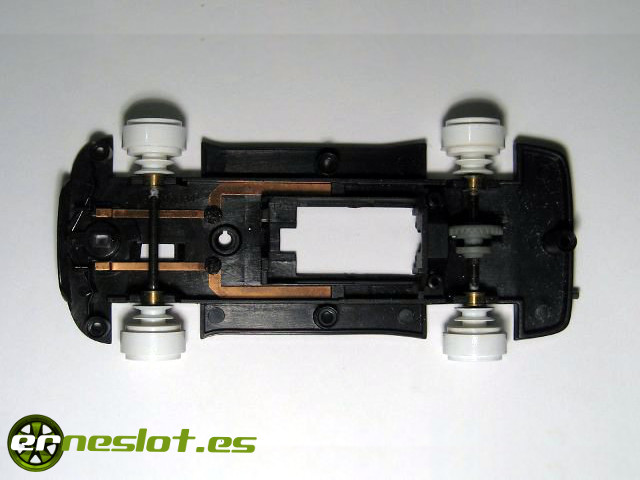
We need to shorten almost 10 mm. but maintaining the four-wheel traction. The best part for cutting is beween the motor and the front axle, as it is the least affects the mechanics of the car. Ideally, you do not have to touch the engine pod and rear axle. It will save us many problems. It is also much easier to change the supports of a axle without drive.
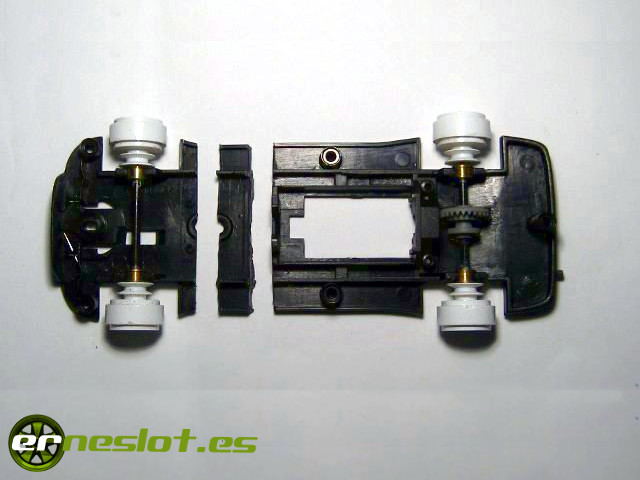
When going to paste the two cutted parts is interesting to help us with other pieces of plastic that serve to strengthen and guide to set the axes the same distance on both ends. In this case I used a pair of evergreen plastic strips glued with bicomponent glue. When hit, we must check that the distance between the ends of the axles on both sides is the same.
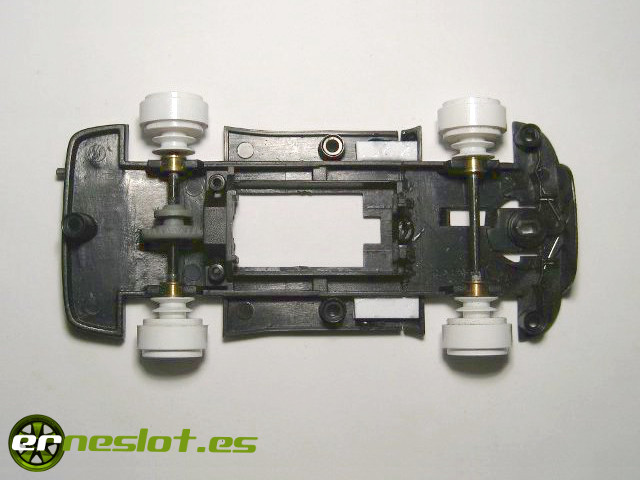
The engine is very simple to adapt, because being a SCX RX81 just have to cut the front axle lenght and fit the gear assembly between the crown and the pinion. If instead of having four wheel drive by gears, had we chosen a chassis with all-wheel drive by belt (e. g. a Ninco Peugeot 307), would have to find a belt to the appropriate dimensions to the new length of the chassis.
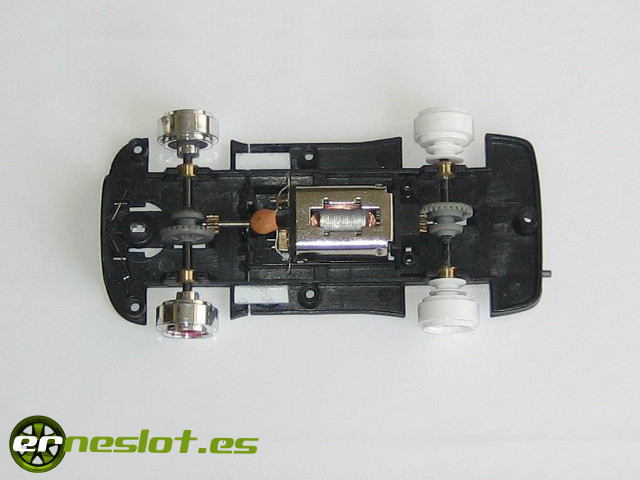
And once we put the plates that connect the braids with the engine already have a chassis with the wheelbase to suit our needs.
In the former case we have shortened the chassis wheelbase, but suppose we need to lengthen the wheelbase. We begin cutting the chassis like in the previous case, where possible allways cutting between the engine and front axle.
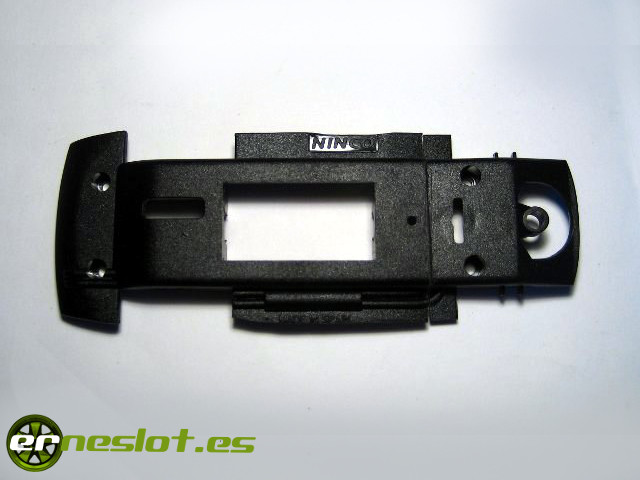
Once cut, we would paste the two stringers, one on each side of the chassis to connect the two parts into which we have divided.
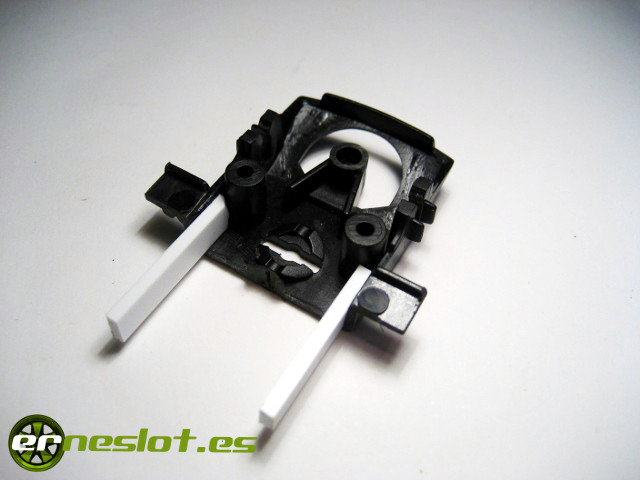
We must be very careful that the axes are the same distance at both ends at the same height. To do so, hitting the chassis on a flat surface like glass or a piece of pottery can be of great help.
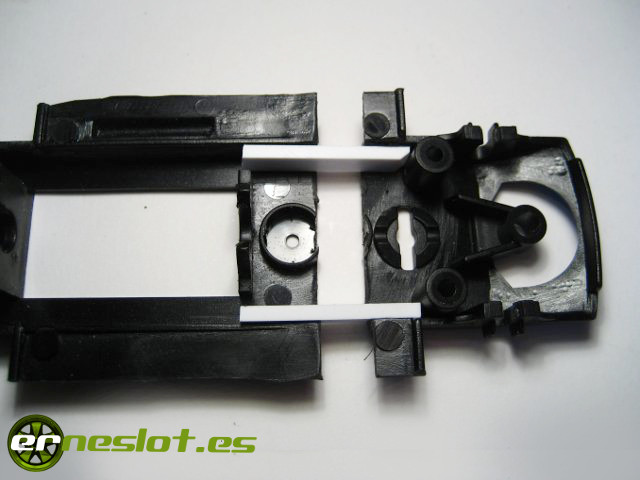
Finally, for the union to be hard enough, we will strengthen it with bicomponent glue once we are sure all the measures are correct.
Thus, with a little work will have a chassis set to the wheelbase of our model. Maybe to finish the job we must cut the sides of the chassis or front and rear ends, or maybe not needed. In any case, those will be minor modifications.
Go to topWHEEL RIMS ADAPTATION
Probably many of you may have a large collection of spare parts for slot cars. In slot racing, wheels and tires are changed by others more adequate or of better quality, engines changed by more powerful ones, cables, braids, more or less straight axles... How many times have we bought a car to compete and we had to change the axles or wheels? or certainly more than once you change the tires to a car because there are better looking another on the market. The result is a small (or large) collection of material that will probably never use it. Well, we can use the tires we have in store for our models in a fairly simple way. With a little patience, we will achieve some tires that fit well with our model, and without spent noney.
I´m making a new wheel rim from six-spoke wheels that mount many car from the Altaya collections (such the Ferrari F40, Ferrari GTO ....), which are these:
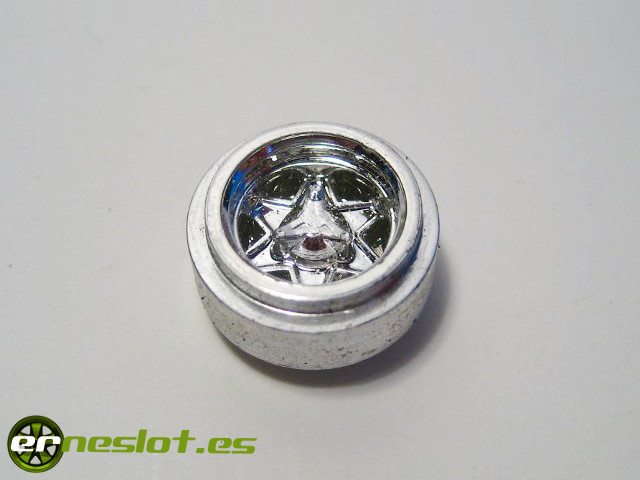
The first is to clear the inside of the rim. In this case, with the help of a mini drill and a small cylindrical grinding wheel we remove the central butterfly nut. It should be emptied with care to avoid damaging the inside of the rim and the axle coupling.
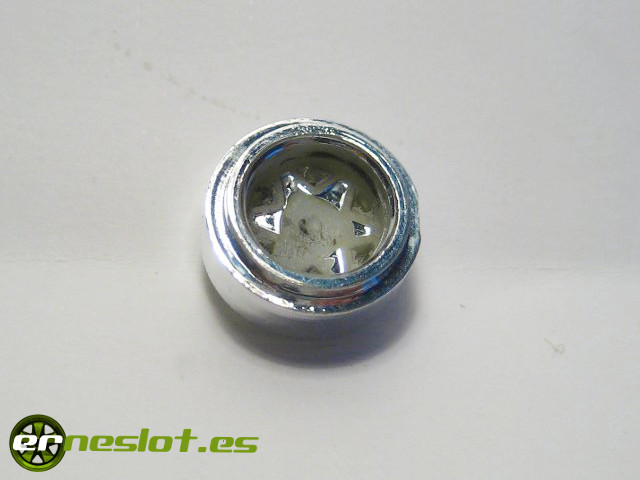
Once the interior emptied, we have to tweak the channel of the rim to fit properly the tire chosen. In this concrete case I use tires from Scalextric, called type 9, which assembled the Renault 8, Alpine A310, Seat and Fiat Panda Abarth among others. We measure the dimensions of the original tire channel, in this case 4 mm wide and 15 in diameter, which would be the ring of the rim should be about 12 millimeters, which would correspond with a tire at 15" at 1/1 scale. With patience and care we go making the channel with a square file and grain 180-220 sandpaper. With a little patience, the result looks like this:
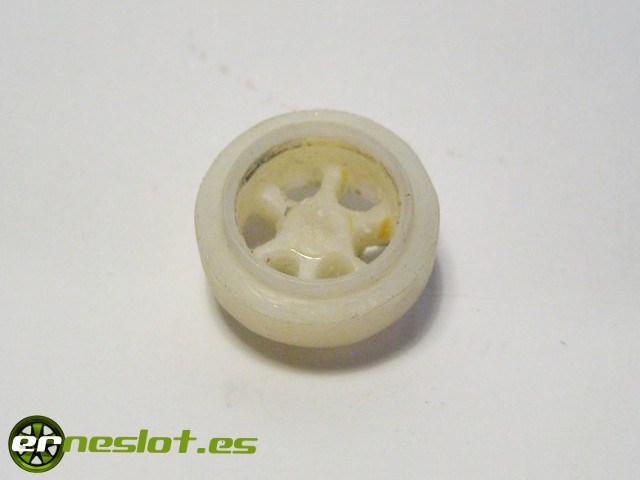
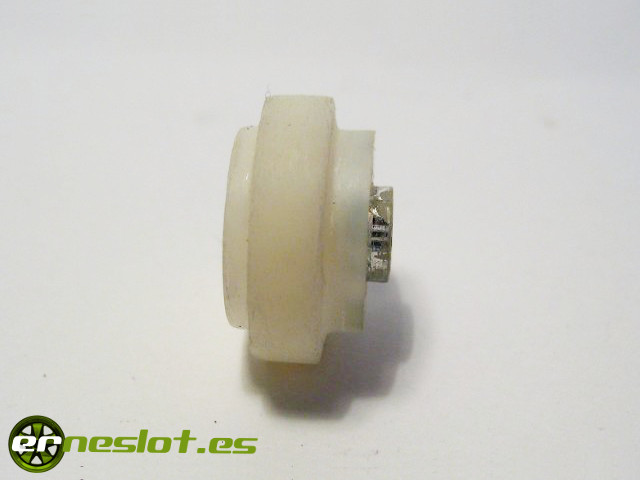
Once we have the channel of the rim well defined and finished we put the resin insert who fits the tire model chosen, in this case, the insert corresponds to the tires assembled in the Renault 8 TS.
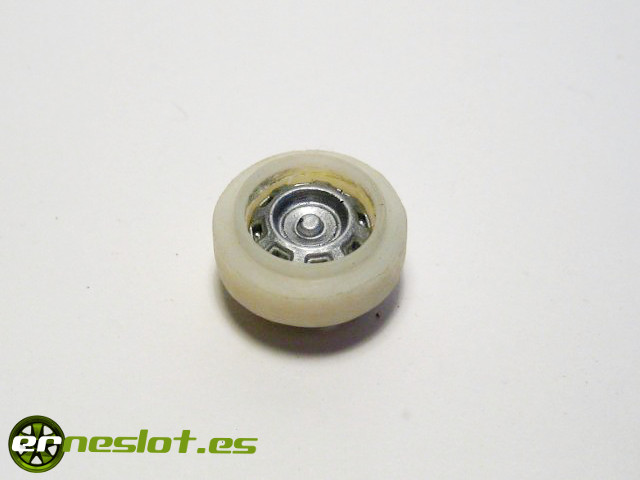
When we put the inserts, we must be careful with the depth of the rim troath. If we went too far emptying the rim, we can use plastic pieces of different thicknesses to fill the gap until the rim be to our liking, and then glue on them trying to keep centered the resin insert. Once we have finished the tires, if we want to reduce its diameter without deforming much, we can mount ir on a axle, place them in a chassis with the engine fitted and make them turn on over an sandpaper for iron until get the desired diameter. It would the same technique that used to center a bit defective tires. However, in most cases we won´t how much the wheells where center because the slot cars won´t be to roll down the track but if we want to roll, the better they doit right, does no?
The previuos would be the most extreme case, where we have to change virtually all dimensions of the rim, most of the times, with empty the rim and put the insert inside we´ll get the tire we want, and with the advantage of reusing material that already we have purchased.
As you can see, it isn´t difficult to reuse material we have in our drawers, in this case abandoned tires, and get very good results. At the end that´s the essence of scratchbuilding.
Go to topPREPARING A RESIN BODYSHELL FOR DECORATION
Prior to working with them, the resin body seemed somewhat mysterious to me and gave me much respect, but once I started using them for my scale models, I realized that it wasn´t that bad. Clearly they need some preliminary work before decorating but not much more than when we worked with a plastic body. If you haven´t decided to decorate a resin because don´t know very well where to start the following lines can guide you.
The quality of the reproductions in resin cover a spectrum ranging from excellent (in quality craft vendors) to "things" that one make at home with more faults than good parts. Within this range we can find everything. In general, the quality of the resins that have passed through my hands has been increasing, partly because manufacturers of resin body have better products and also because cloning techniques are better, but it doesn´t mean that we don´t find models with faults, and is that the molds for resin bodyshells (which are made of silicone) loose quality and definition as they are making copies of a model. If we have the luck that our model is one of the first copies made from the mold will have less work to do on the bodywork.
The steps to leave prepared to decorate a resin body are:
Fit car mechanics. I am in favor of allways manipulating the body before decorating to avoid damaging the paint or something, when we have bare the bodywork there´s no problem to brush the paint, for example. So when to the model I have removed the most obvious failures (mold burrs) I adjust the chassis. Usually I use a commercial chassis that fits well with the width and wheelbase of the body, and whenever possible, I joint it to the body by evergreen lugs stuck to the body using bicomponent glue as seen in the following photos:
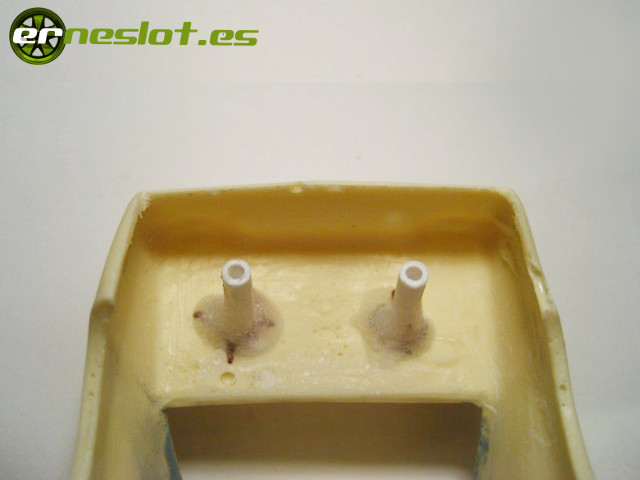
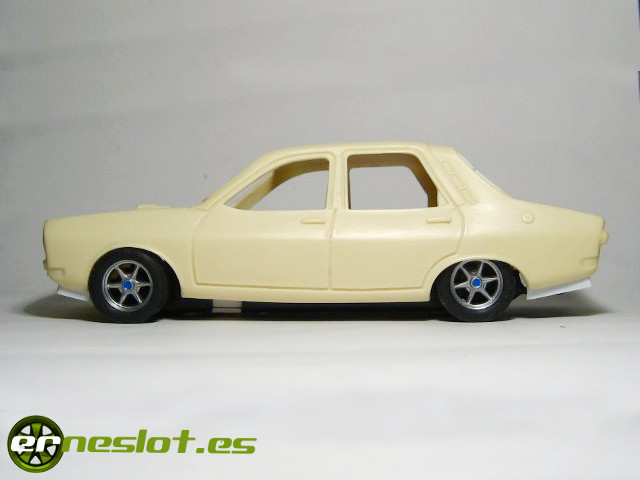
Special care will must have with the interior of the model, maybe the engine can now touch with the drivers tray. As always, lime, sand and patience will help to bodywork, drivers tray and chassis fit perfectly.
Adjust the glass and the rest of the body elements. If our model has vacuform acetate crystals is interesting to try to fit them as much as possible before decorating the body. It´s difficult to fit the windows perfectly, but you can always improve the fit by sanding the inside of the body, for example. It´s a nuisance to have the car painted and decorated and see that the front glass doesn´t fit well into its hole as we can spoil the decoration trying to adapt if we aren´t careful. The same applies to accessory elements of the body, such as mirrors and bumpers .. You may also have to open the windows that appear sometimes closed by a thin layer of resin, with a cutter will open the holes carefully and we will review again with fine sandpaper. The task of adjusting the glass is usually heavy but the end result is worth it.
Retouch the body. After the mechanics and glasses, we will do the finishing touches to the bodywork:
- Remove any burrs with a smooth sanding. Carefully go deburring the burrs the mold has left with a fine sandpaper, a 220 grit for wood could be fine, being careful not eat more than necessary. If the body is of very good quality this work is limited to few points.
- Add material where missing. Due to the manufacturing process of the body, there are times when air bubbles are trapped between the mold and resin, which make holes in the bodywork or some parts appear incomplete. Depending on the size and the area containing the hole, we can cover it with a bit of putty (Pattex stick or similar), stick a piece of plasticard/evergreen, or both.
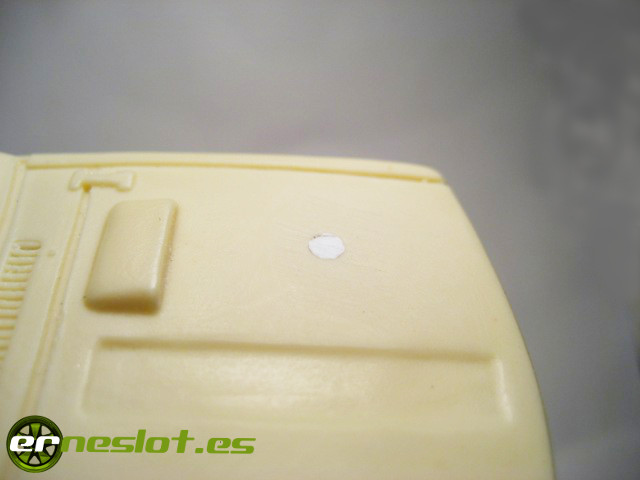
- Remove air bubbles. Sometimes small resin bubbles will appear over the surface, especially in vents and fissures of the body, such as those who appears next to the hood latch in the following photo.
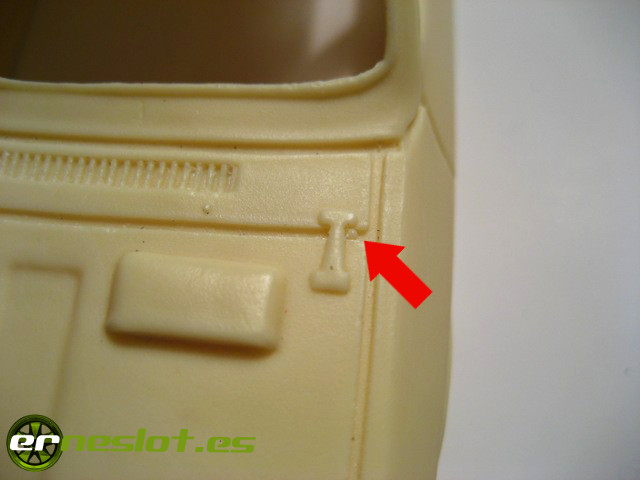
With a pin or a thin needle can be safely removed.
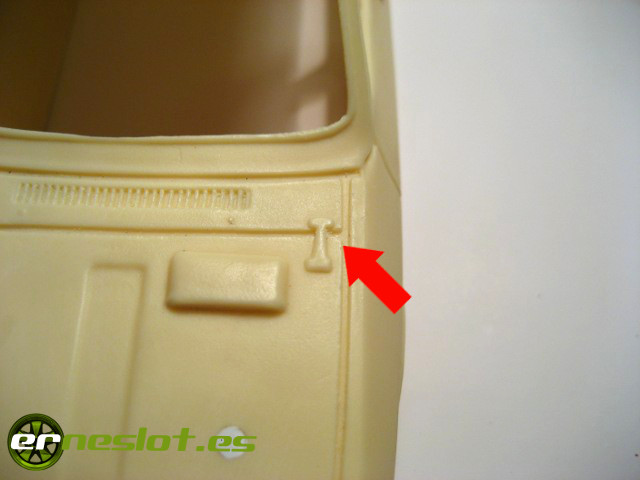
- Retouch the bottom of the body. The bottom of a resin body are likely to be poorly reproduced by failure to manufacture the bodywork. They may be lack of material, can be bubbles, might not be properly outlined the shape of the body ...., failures that will require that part get retouched. Sometimes with a little putty solves the problem, but if the problem is more serious, we must rebuild the bottom. In the example below the front and rear of the car has some faults and their shape is not correctly defined, so let's fix it.
First paste a thin strip of evergreen/plasticard with bicomponent glue on the inside. The intention is the strip to support the putty applied later.
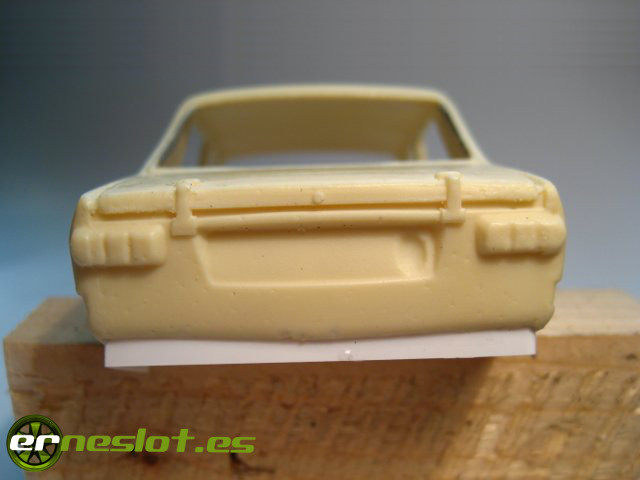
Once well glued the strip, apply bicomponent putty. For these cases I often use Nural 41. If were a car used to run on track better use other putty, which is more flexible and impact resistant, even it is worked worse.
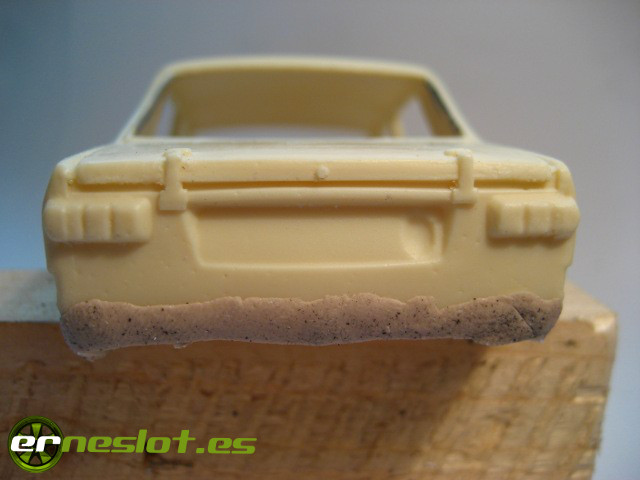
Once dry, with sandpaper will give the proper shape to the putty. - Cover the pores. Rare is the resin body that doesn´t have a pore, but there are some who have many... Here is an example:
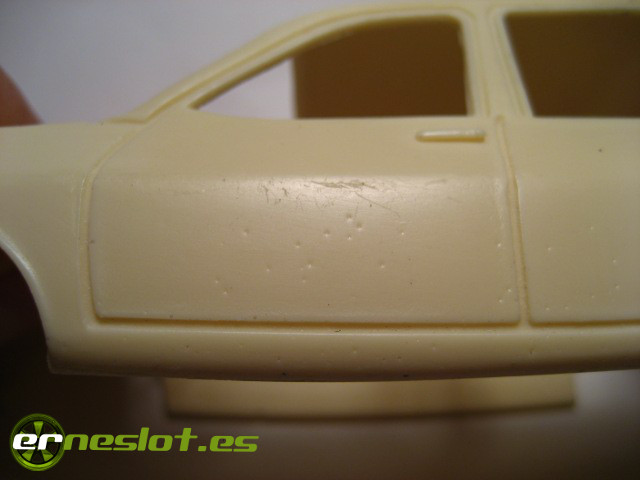
To cover them, the best way is dilute a bit of Tamiya Putty with pure acetone and apply the mixture with a brush as if we were painting the area. The mixture will become more dense as the acetone will evaporate. Depending on the depth of the pore, we can apply the mixture more diluted or thicker:
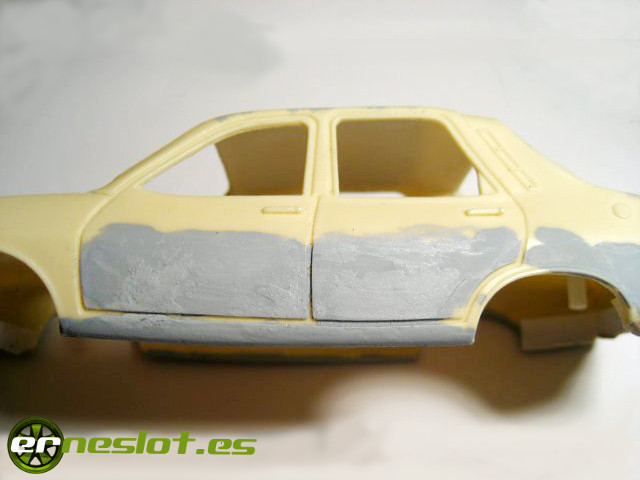
When the cputty is dry we will match the surface with some smooth past with used waterproof sandpaper, for example 220 grit. Finally, after a thorough cleaning with water and dishwasher, a coat of primer will allow us to see faults that had gone unnoticed and as a basis for painting:
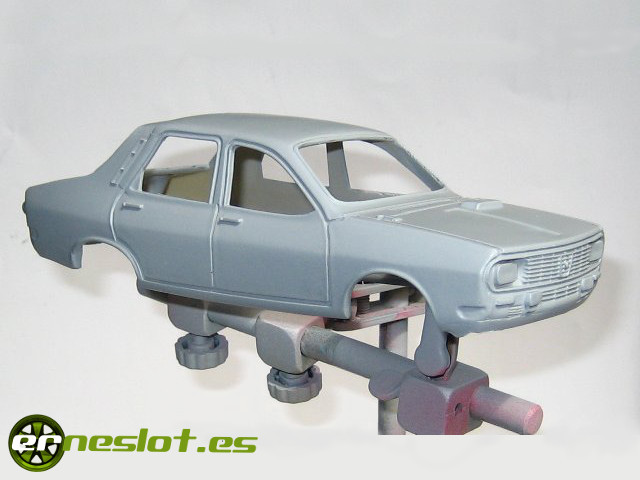
Thus we will have a resin body ready to decorate. As you can see, the work does not have any complications, .just the bodies of resin has a little more preparation before decorating than a plastic body, but little more.
Go to topCREATION OF A COMPLETE INTERIOR FOR A SLOT CAR
The changes or improvements in our slot cars don´t need to be limited to the body or chassis of the car. If weight is not a problem in our model and if we go a step further in the reproduction of the car, provided that the provision of car mechanics allows us, we can make a complete interior and not just a flat drivers tray.
Indeed, to make a complete interior of a car will depend critically on the arrangement of the engine in the chassis. If the model has central transverse or front engine we can fit a complete interior, however if the arrangement of the engine is central longitudinal or "anglewinder" we probably can´t make it due to lack of space.
In this case, I'll do a full background to a ProSlot Porsche 911 GT2. First, the engine layout (central trasnversal) allows me to fit together well and for the other part original drivers tray is horrible:
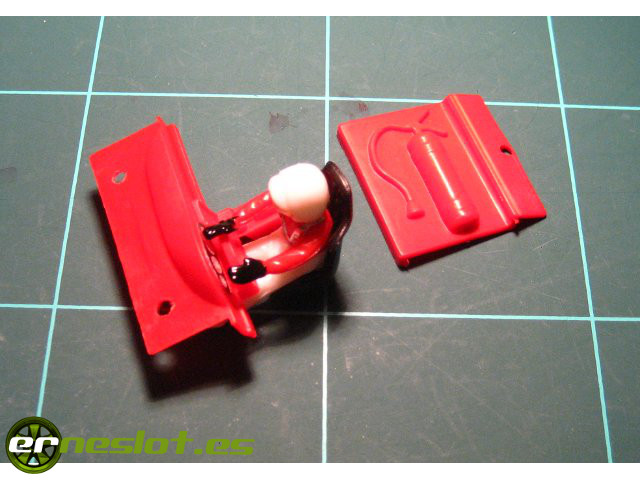
To make the new cabin we need to know the measures of the body interior where it´s going to be embedded. We will use squared paper or, better still, graph paper to graph the drivers tray that will serve us as a starting point, assuring the correct fit. The advantage of doing it on paper is that is that we can repeat all times we need to get the appropriate template, and if it is graph paper instantly know the right dimensions.
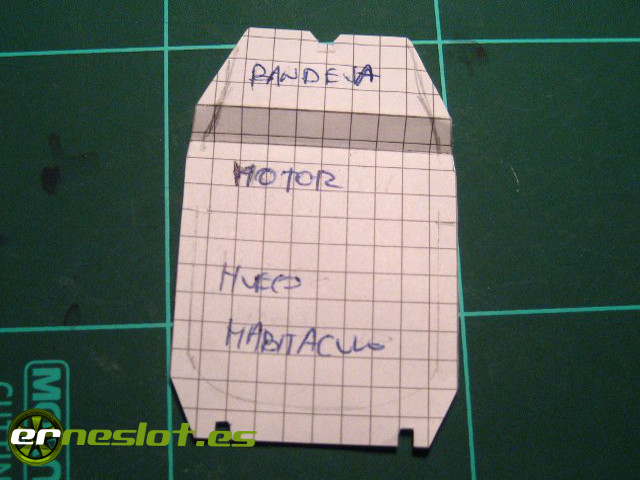
When we have the definitive template we cut the plasticard sheet, in this case 0.75 mm. thick. The sheet may be somewhat thicker or thinner, but the 0.75 mm. sheets have a good compromise between rigidity and lightness.
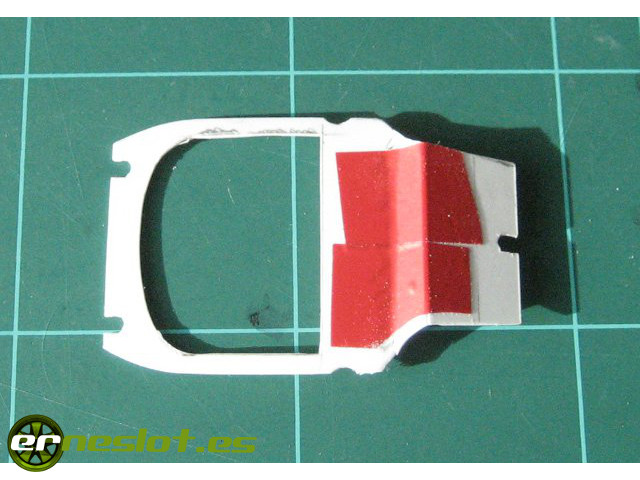
We already have the piece that defines the interior of our model, we now have to cut from the plastic sheet the other pieces that forms it:
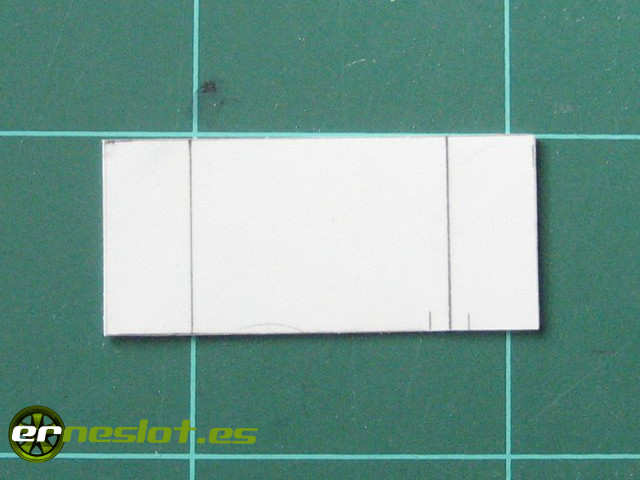
The pieces are glued together making a kind of box:
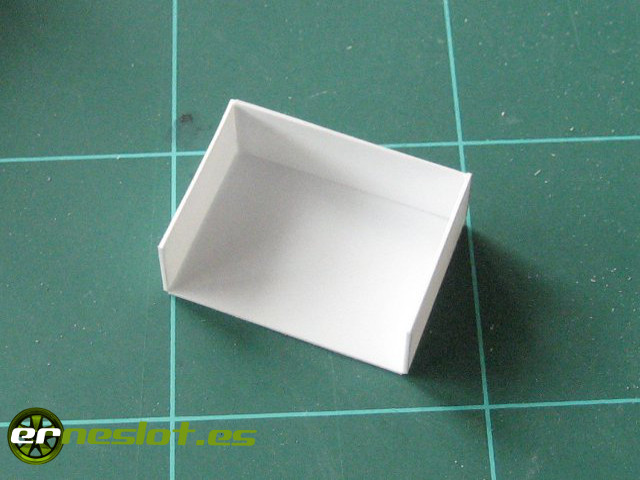
When we have the box made, we glue it to the tray and see if fits well into the body and doesn´t touch with any mechanical element (cable or motor) and the chassis is well embedded into the bodywork. Having made the findings, glue all the pieces of the interior with a strong glue, I always advise bicomponent glue who once dry will allow us to manipulate the piece without problems.
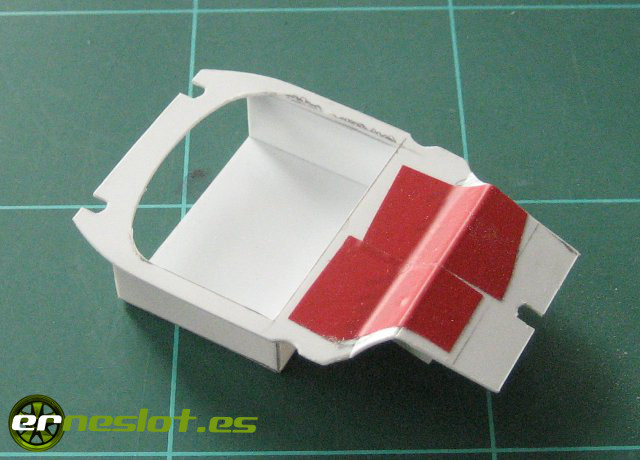
The dashboard is a very important part of the car if we do a complete interior. As we have space, we can actually enjoy doing one with strips of plastic and putty or copy in resing the dashboard of another scale model, for example. In this case I chose the second option. From a 1/32 scale model car I get the dashboard, I make a mold with clay and filled with poliuretane resin. After drying the resin we have something like this:
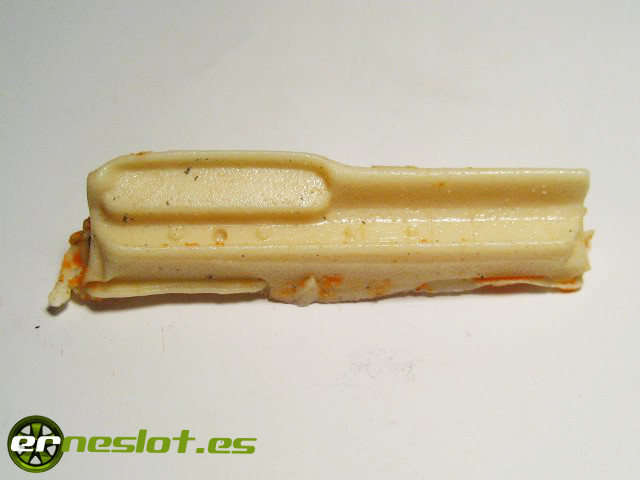
Some faults and imperfections but is more than enough for what we want to do.
After adjusting the resin dashboard, we glue it to the interior that we have done, being careful with the adjustment of the crystals and the interior within the body is correct.
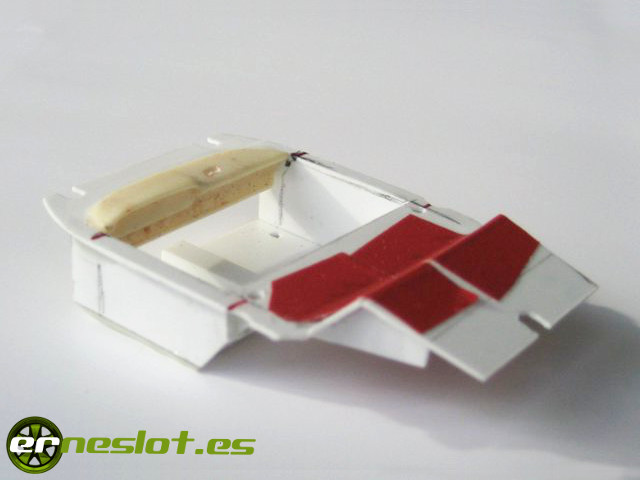
Finally, if space permits, we can make a roll cage for our car. With plastic rod glued together and reinforced with bicomponent glue can do whatever we want:
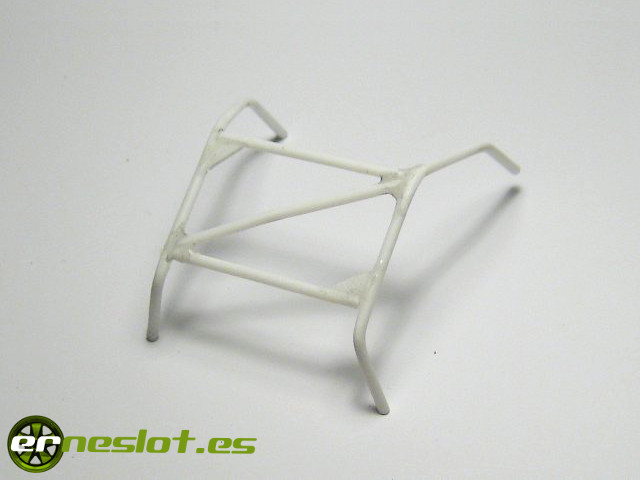
To finish the work, as is enough space, place a seat and a full body driver. The drivers are easily available to get and the seat can be done with evergreen or plasticard sheets, or buy too.
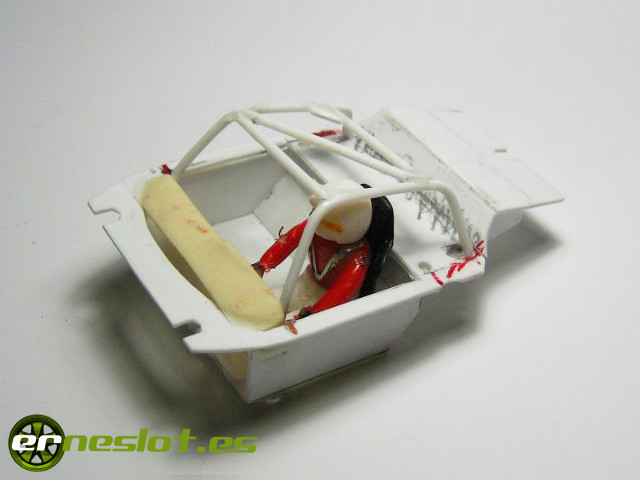
And that´s all. With the interior done what we can decorate to our taste. Never be lacking the steering wheel, shifter, seat belts and a fire extinguisher, but we can always recreate more decorous, for example, with the wiring inside the car made with guitar strings of different thicknesses or anything else that comes to our mind.
Go to topHOW TO GET A RESIN COPY OF A CAR
Spent some time on a model and for whatever reason we want to make copies. Maybe we like various decorations of the model, maybe we have the intention of give copies to friends, or sell them... Anyway, when we want to make copies of a model, rather than repeating the work from the start, it's best to copy it in polyurethane resin. Thus we have exact copies of the car with little work and very good quality.
Copying or cloning of models in resin is a common technique in the modeling. It consists in create a silicone mold (or several if the model is complex) then we fill with polyurethane resin who once solidify give us a copy of the desired model. It is a simple task but it requires to do it carefully. In this section I will explain how to make a copy of a bodyshell and to do this we need the following tools:
- The starting bodyshell well finished
- Plasticine
- A container for the body
- Silicone rubber for cast and a mixing bowl
- Vaseline or some other release agent
- Polyurethane resin and a mixing bowl
The starting bodyshell must be well finished and clean, so to make copies the defects will be minimized.
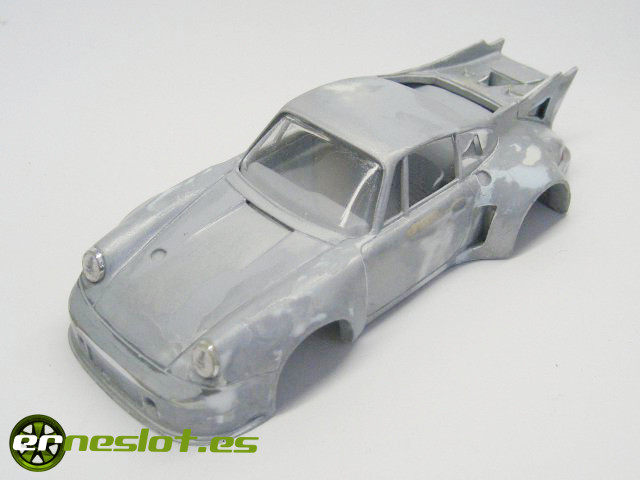
First off all we will cover the windows and other openings so that when we pour the silicone don't let it slip inside and spoil the job. In this sense remark that:
- If we intend to clone the bodyshell, it is best to go doing the work with this in mind. I mean it is better to cover ourselves holes with putty and plastic than to have to hiding then plasticine. On the other hand, if the body has wings and other parts that protrude far better put them aside the body without hit and then make a them copy separately. Following the example of the RSR, I covered the front air intakes with putty on the inside, the front and rear lights stuck in place with wood glue (easy to disassemble). The intention is to leave the body only necessary openings (windows, for example ..).
- The more independent parts the body have (lights, mirrors, grills, etc...) more work will be to copy the model because we have to make casts aside for all the pieces, but then the result once finished the model usually is better.
- To cover the windows, stick masking tape on the inside of the body trying to adjust as possible. In the same way I do with openings for air intakes. Whenever possible, it is preferable to plug holes with tape than with plasticine (it is easier to remove).
When we plugged the holes well, fill inside the body to make a solid block. It is usual to use plasticine to do, trying not to cover body parts that we want to be well reproduced, such as the bottom of the doors.
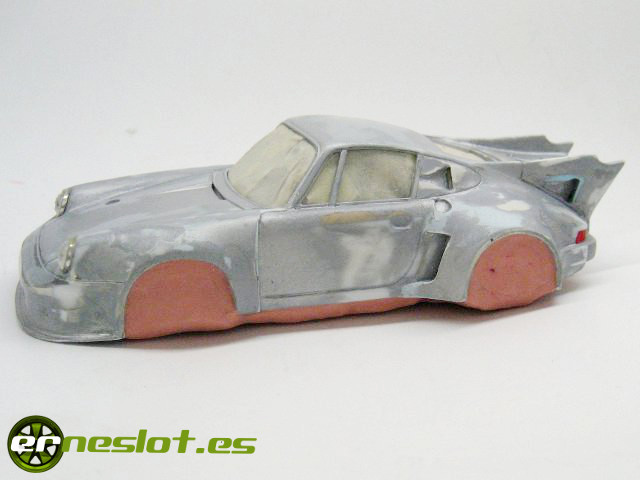
It is important that the plasticine does not overflow much of the body, indeed, in some parts, such as wheel arches, it has to be a little inward to make a fit with the inside cast that we will do later.
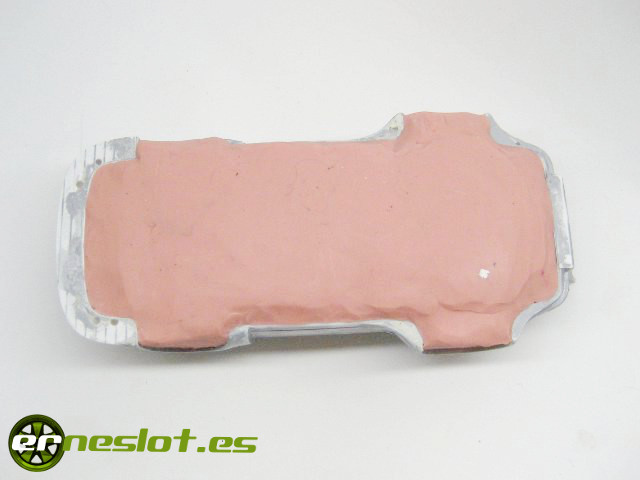
We put the body in a plastic container, cardboard or other material that enables us a easily demolding, such as a box made with LEGO building blocks, or similar type.
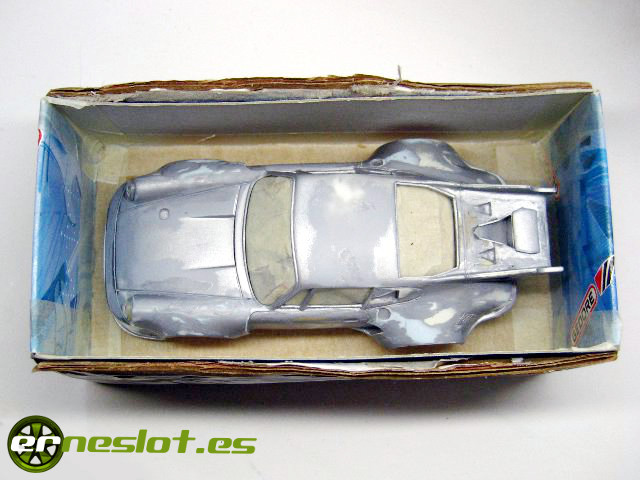
The product used to make the mold is silicone rubber. It is a bi-component product, first silicone and the other a catalyst or hardener to be mixed in a proportion to get the product that will fill the mold of our model.
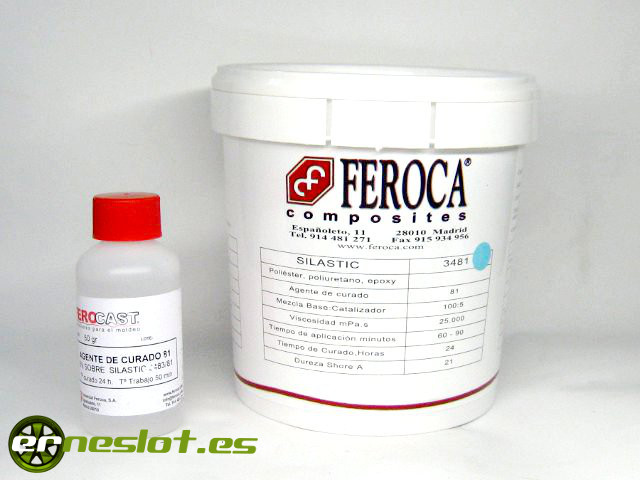
When using the silicone will take into account:
- Security Must always work with rubber gloves, rather than by its toxicity, because the silicone strain.
- Mixture proportions in which I use must to be mixed 100 parts of silicone with 5 parts of catalyst, but be aware that silicone is much more dense, in fact, the kit includes a bottle of silicone 1 kg. and a 50 ml catalyst bottle. In my first attempts made the mistake of basing proportion of both products to the volume , serious error, because silicone at equal volume is heavier than catalyst and mixing it with less catalyst than appropiate, the result is that there was a very thick mixture that took too long to vulcanice, and the results were really bad. The right thing is to make the mixture in terms of weight, 100 grams of silicon with 5 grams of catalyst. In the case of catalyst I usually measured in milliliters because for each gram is almost a milliliter like water so I can take the correct amount measuring of catalyst with a syringe, for example.
- Mix well and let stand Once mixed products we have arround an hour to use them before they harden. It is more than enough time to mix the products, so we can make the mixture slowly, making sure that both components are well mixed, then let them stand a couple of minutes to the disappearance of the air bubbles that may have be formed. It is important that the mixture be homogeneous and has few air bubbles.
- Pour the silicone over the body We must do it slowly and never above the body, but on one side and is silica which is filling the holes to completely cover the model. It is very important to do it slowly so that all gaps are covered and the air bubbles rise to the surface. The bubbles are "dangerous" because they can damage parts of the mold, which can be important or not, but the best is avoided them as far as possible.
- The time of vulcanization Silicone poured hardens completely at 24 hours, which varies depending on environmental conditions. Generally, if the mixture is well done it can be removed by at that time without problems. If the proportion of silicone / catalyst is not correct, it may take much longer to harden, or never do, hence the importance of making the mix properly and appropriately proportioned.
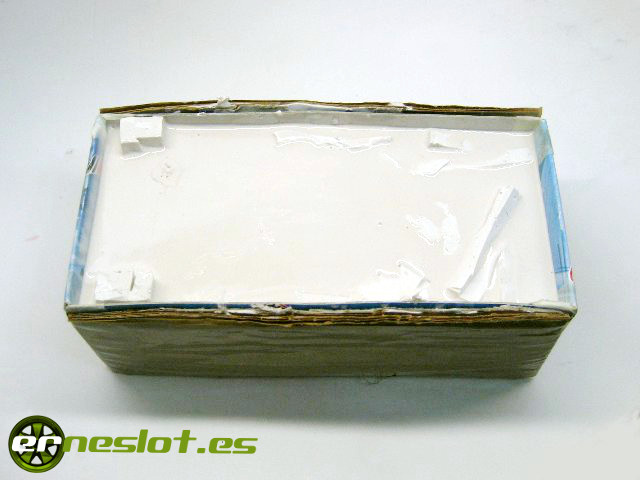
In the photo above is seen as the mold is covered with silicone. The pieces that stand out are pieces of earlier silicone molds that no longer apply. Instead of throwing, cut the defective molds and pour with the silicone to fill large holes, silicon will joint to chips to form a compact block. Besides save silicon, use the old molds.
Once the silicone fully cured proceed to stripping. Carefully separate the silicon from the body. We'll have one parte of the mold, which makes the outside. If you look, there can be some silicon chips inside that will be removed with scissors or cutter, always careful not to damage the mold. In the photo below is pointed one of those chips with a red arrow. When we have the cast without burr so clean with soap and water.
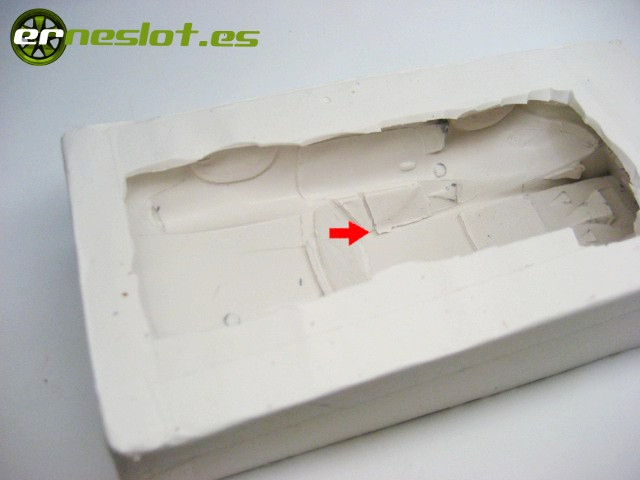
Through the above process we have a mold to make the exterior of the body, we must now make the mold of the interior get a copy of our body. Thoroughly clean the mold we apply Vaseline or any other de-moulding agent inside with the fingers or a brush, the case is that it is well saturated. Once done, put the body back into position after cleaning it and open all the holes that had previously covered with tape or plasticine.
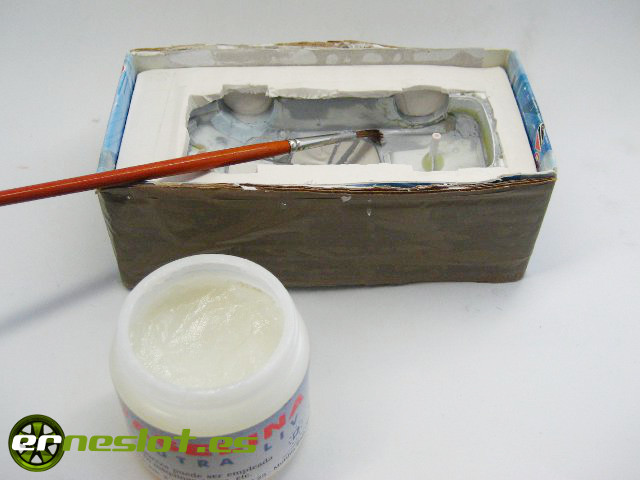
Prepare more silicone and catalyst mixture and pour it carefully as we have done before, slowly letting go on supericie bubbles and filling with pieces of old molds (if have it) to spend the least amount of product possible.
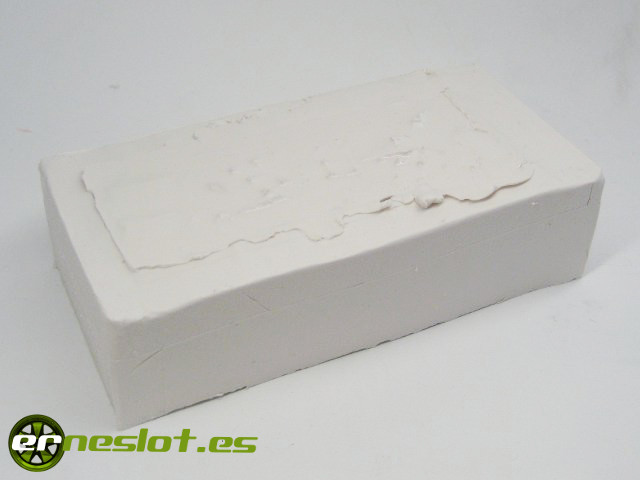
After leave 24 hours cure strip with care, removing burr and defects of the mold and wash the piece again. Thus we have achieved our two-piece mold for a body.
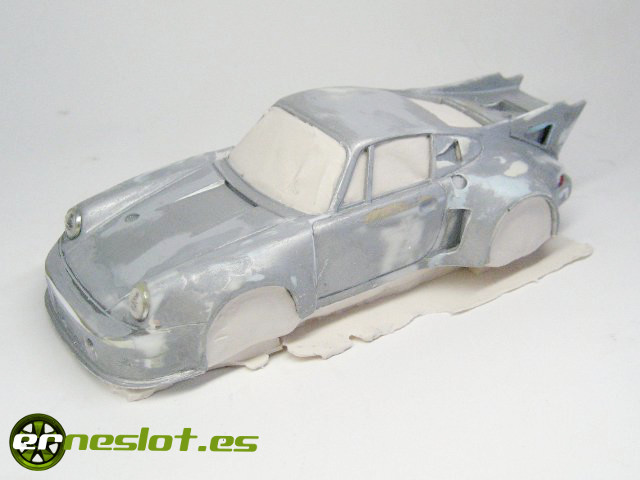
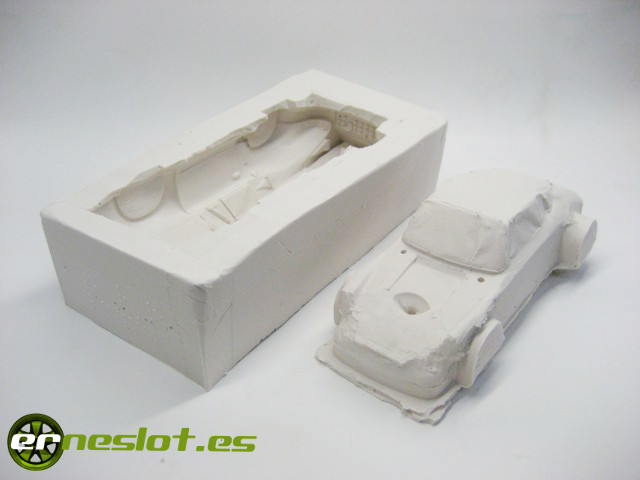
Now comes the easy part, fill the mold with polyurethane resin.
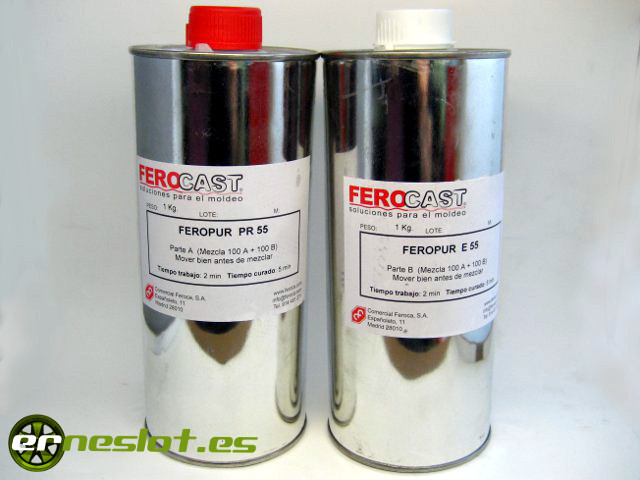
The polyurethane resin I use is the one in the photo above and is formed by a equally mixture of two compontes which greatly simplifies the job, but we must be very fast mixing the components and pouring the mixture into the mold because it hardens very quickly. With the resin we must consider:
- We must have two containers to measure the amount of each component and another in which make the mixture to pour into the mold. Measuring containers can be simple plastic cups where we'll drop the same amount of each product. The mixing container is important to have spill hole for easier pouring the mixture into the mold.
- Being a mixture of two components have to go step by step by calculating the quantity of product needed for mixing because unlike the silicone rubber resin can not be reused. It is better to fall short the first few times to do too much resin and then having to throw it away because it has hardened.
- When pouring the mixture into the mold we will ensure that all goes well in corners. I pour almost the entire mixture into the mold and fit in carefuly the other mold ensuring that no air bubbles were trapped. Once both mold embedded somewhat in the predicament where most likely can get the air bubbles to help expel. The rest of the mix I drop for the edges to make sure that the amount of resin is sufficient to completely fill the mold and which are not parts without reproduce due to lack of resin.
- In the chemical reaction that produces the resin cure temperature increases, wait for the resin to cool to detach the body to prevent deformation of the body. The total process from which pour the resin into the mold to get the bodyshell is about 15 or 20 minutes depending on temperature.
And if we have done all the steps rather get a body like this:
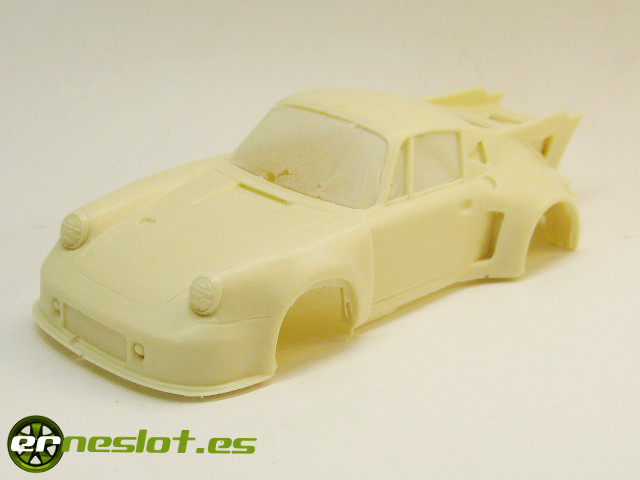
Make a body mold is not hard as you can see, you just have to know the process and be careful, especially in the mixture of the silicone and when poured on the body. Otherwise it is a simple task.
Molding products displayed in the explanation are what I use but on the market there are plenty of silicone and resins that you can use from the same manufacturer or from other manufacturers.
Go to topFortnightly updates, new cars and more in www.erneslot.es



